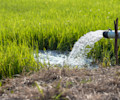For years, agricultural pollution has sat uneasily in the background of climate and environmental debate – understood, but rarely discussed and not treated as a serious legal or financial risk. That is no longer the case, however.
The Guardian newspaper has recently exposed how many intensive livestock farms have failed to declare their climate impacts, while the BBC has reported on legal action challenging agricultural pollution in three UK rivers and its effects on local communities.
Additionally, research from food and farming alliance, Sustain, shows that some UK livestock megafarms are routinely failing to disclose their climate change and emissions impacts, exposing the sector to mounting financial and legal challenges.
The timing of these revelations could not be sharper: FAIRR’s latest Waste and Pollution engagement progress report paints a picture of steady improvement on risk assessment among livestock producers regarding pollution caused by the improper management of animal waste and synthetic fertiliser products, but limited follow-through on mitigation and transparency.
Despite small steps forward, most protein and fertiliser companies remain unprepared for increasing scrutiny around waste, water, and nutrient management. With regulators, investors, and communities now watching closely, agricultural pollution is fast becoming a material issue that companies cannot ignore, as this Insight highlights.
More companies are assessing water risks, but not disclosing them
As highlighted in The Cost of Contamination: Addressing Water Pollution Risks in Intensive Animal Agriculture, 83% of engaged companies have now undertaken water-quality risk assessments across their operations, a meaningful improvement from 60% in 2022.
However, very few companies disclose which operations face the highest or medium-level water-quality risks. Without that information, investors cannot judge exposure or track how closely companies align with regional environmental guidelines, and markets are prevented from accurately pricing water and pollution risk.
Supply-chain visibility improves, but must do better
Encouragingly, more producers are beginning to extend environmental risk reviews beyond their direct facilities. Around 70% of pork and poultry companies now include livestock supply chains in their risk assessments to some extent, compared with just 10% in 2022, while 40% assess their entire livestock supply chain (including own, contracted and third-party farms).
This is an important improvement, given the interconnected nature of feed, land use, and manure disposal, yet the full picture is still fuzzy. Many producers are only assessing a fraction of their suppliers, often excluding smaller farms where oversight is weakest and waste mismanagement most likely, and only 30% include feed suppliers in their assessments.
In 2005, a lawsuit was initiated against several poultry producers, including Tyson Foods, arguing that chicken waste from locally contracted farms, used as fertiliser on nearby land, had contributed to the pollution of the Illinois River watershed in Oklahoma.
While a US district court ruled in favour of the lawsuit in 2023, the companies have not yet reached an agreement with Oklahoma on the pollution reduction measures they will take. In July 2025, the State asked the court to fine the poultry companies for each day of pollution since 1990. For Tyson Foods, the total bill would be an estimated US$28.9 million.
This example illustrates the potential consequences of poor supply chain visibility: when pollution or emissions data is partial or inaccurate, companies not only face reputational harm and serious compliance and financial exposure, they also breach the trust of regulators and investors.
From risk assessment to real-world mitigation
While assessments are on the rise, mitigation remains an outlier. Only one company in FAIRR’s engagement has disclosed clear targets to reduce pollution in high-risk areas. In most cases, risk identification has not translated into measurable action. This lack of implementation matters. Regulators are tightening water-quality laws and investors increasingly expect disclosure of mitigation plans, not just awareness statements.
If companies continue to focus on data collection without investing in prevention and remediation, they could face liabilities ranging from penalties and cleanup costs to market restrictions.
Effective mitigation strategies, such as improved manure management or investment in pollution reduction at processing plants, could significantly reduce long-term risks and costs.
The fertiliser sector’s missed opportunity for circular solutions
Phase 3 of the Waste and Pollution Engagement has also highlighted persistent inaction among fertiliser producers. Despite their potential to foster a circular economy for nutrients, such as supporting the re-use of organic fertilisers or developing products that minimise runoff, no major progress has been made.
Most fertiliser companies have still not evaluated the risks associated with their products or implemented concrete circularity strategies.
A lack of financial incentives and slow policy momentum are partly to blame. But this inertia could quickly become a competitive disadvantage if new regulations and subsidies begin to favour nutrient recycling and waste reduction technologies. Momentum to address nutrient circularity is building - at COP 30, Brazil and the UK announced the Belém Declaration on Fertilisers, a call to action to improve the production and optimisation of fertilisers.
Firms that move early to address these issues will gain most in cost savings, innovation, and stakeholder confidence.
Pollution and water risks are financial risks
For investors, these findings are more than environmental updates - they point to material, quantifiable financial exposure. Pollution incidents can trigger fines, litigation, reputational backlash, and operational shutdowns. Rising community activism can further amplify these costs and make environmental liability a tangible balance-sheet problem.
Additionally, water pollution risk can be interpreted as a proxy for wider governance shortcomings, as the recent credit rating downgrade of UK utility Thames Water demonstrates. A company that cannot monitor waste responsibly may struggle with compliance elsewhere - concerns that could impact investor sentiment, limit financial support and reduce shareholder value.
Time for transparency and action
The convergence of regulatory, social, and financial pressures means that agricultural waste and pollution are no longer peripheral issues. They stand at the core of corporate resilience and investor confidence. Companies that treat pollution as a manageable, data-based risk, rather than as an operational inconvenience, will be better placed to adapt as the policy environment evolves.
FAIRR’s engagement findings show both progress and persistent inertia, but the message is clear: it’s time to move from assessment to action. Greater disclosure, credible mitigation targets, and investment in circular solutions can create value and strengthen long-term competitiveness.
To explore these findings further, join FAIRR’s upcoming webinar at 14:00 GMT on Tuesday, 2 December 2025. Hear experts discuss key insights from the engagement and examine how proactive waste and pollution management can help companies and investors better manage financial and reputational risks.
Register now: Meet the Expert - Waste and Pollution Engagement
FAIRR insights are written by FAIRR team members and occasionally co-authored with guest contributors. The authors write in their individual capacity and do not necessarily represent the FAIRR view.











